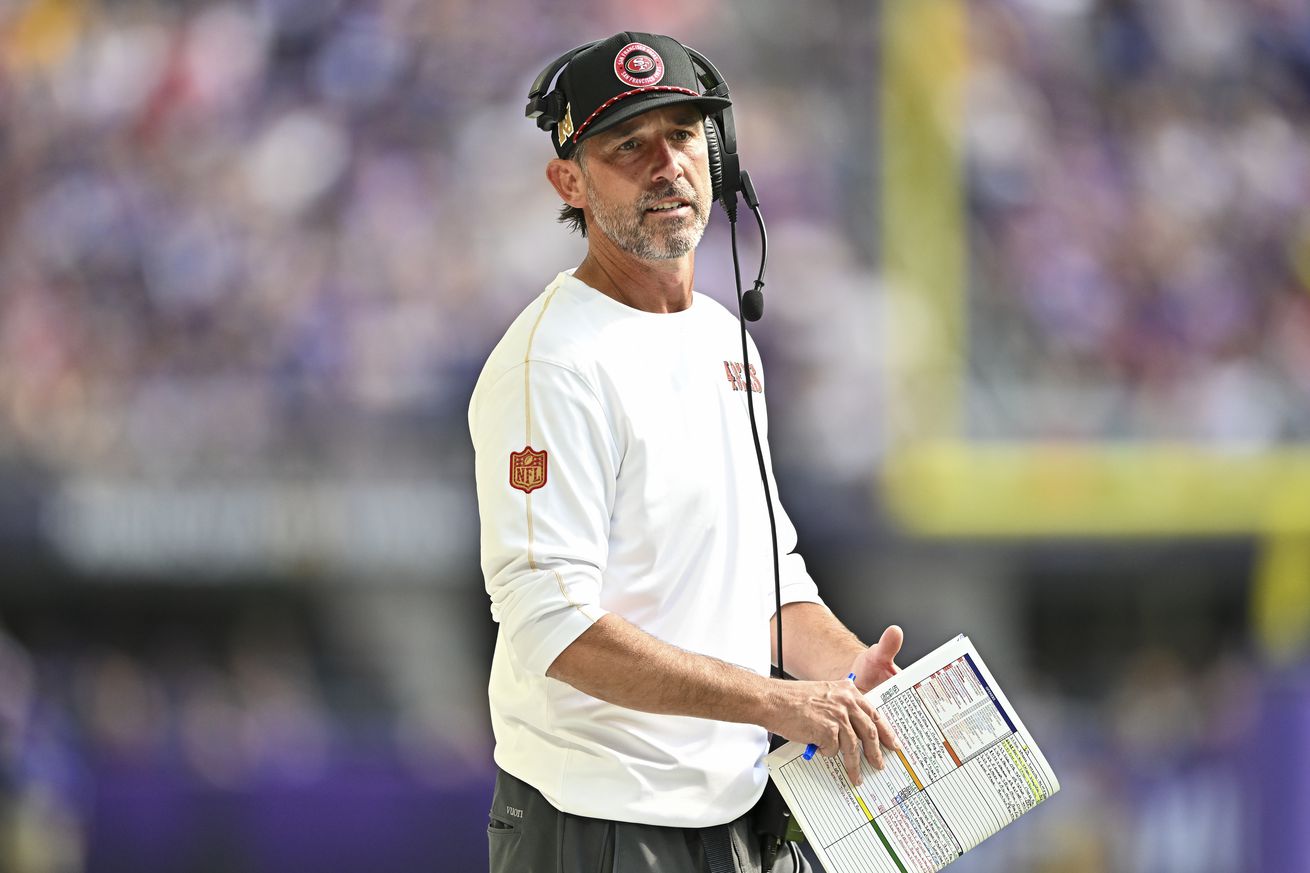
The 49ers’ head coach is one of the top offensive minds in the NFL today.
The San Francisco 49ers may be 1-2 heading into their upcoming matchup with the New England Patriots, but their offensive output this season has still been solid. Not accounting for non-offensive touchdowns, the unit led by quarterback Brock Purdy ranks sixth in the NFL with an average of 24.3 points per game.
A number such as this one can be deceiving, though, if not properly contextualized. And for the 49ers, context is very much key: San Francisco is among the top offenses in football despite star running back Christian McCaffrey not yet having appeared in a game, and both tight end George Kittle and wide receiver Deebo Samuel missing time due to injury.
Purdy himself has had an active hand in the 49ers’ offensive success so far; what he may lack in pedigree he makes up for in effective play. However, the main man on that side of the ball is somebody else.
Head coach Kyle Shanahan is the one pulling the strings, and expertly so.
Now in his eighth year as 49ers head coach, Shanahan has managed to put his own spin on an offensive system that has taken the league by storm over the last decade. Of course, the origins of that system carrying his family name can be traced back to the mid-1990s with his father Mike — as well as other such as Gary Kubiak and Alex Gibbs — first implementing it in San Francisco and later in Denver.
Three decades later, his son continues to refine and modernize it. The core principles, however, remain the same as the Patriots’ coaching staff pointed out this week.
“With Shanahan this just doesn’t go back years, this is decades — decades of an offense that was built over time,” said defensive coordinator DeMarcus Covington.
“You can look back to when his dad ran the offense, and the coaching tree that he has throughout the NFL. I have mad respect for the way that they run their offense, the style that they do it. The running game, the complements, the motions, the passing game, everything they do off of it. To me, it’s a great scheme that they have come up with over decades.”
“If you look at battle-tested schemes over time, this offense is one — not only there but there are branches of that tree — that presents a lot of problems in the run game, play action, and drop-back pass,” added outside linebackers coach Drew Wilkins.
“They’re able to get vertical and horizontal advantages on you based on their speed, and their talent, and their scheme. It’s a really good challenge. Kyle Shanahan, one of the great play callers in the league, understands how to attack defenses.”
The younger Shanahan started out under his father’s former colleague Gary Kubiak in Houston. He later joined his dad in Washington, on a staff that also featured future NFL head coach Sean McVay, Matt LaFleur and Mike McDaniel — all having since put their own spin on the system.
But while the scheme has evolved significantly since Mike Shanahan ran it, the core principles remain the same. Tops among them is a wide zone-based running game that Kyle ran with the Atlanta Falcons and since his arrival in San Francisco in 2017.
However, the secret lies not so much in the “what” but rather the “how.”
Patriots defensive line coach Jerry Montgomery, who coached under LaFleur in Green Bay, explained just that earlier in the week.
“Kyle’s one of the best play callers in the NFL. He’s got some talented guys, but for the most part he’s very unique in how he calls the game,” Montgomery said. “They do a phenomenal job of window dressing very simple concepts that they have. They probably run this concept 20 different ways if they get to it, but it’s the same concept.”
“Every single play, you’re going to see motion, and you’re going to see exotic types of motions. They’re trying to get you to adjust a certain way,” said head coach Jerod Mayo.
Going up against the Shanahan offense, be it run in San Francisco or elsewhere, is therefore a game of cat and mouse. The Patriots have been on both sides through the years.
Back in Super Bowl LIII, they used 6-1 fronts and late shifts to better McVay’s version of the offense in a 13-3 defensive masterclass. Two years later, they couldn’t keep up with Shanahan’s 49ers consistently out-flanking them in a 33-6 defeat and later lost 24-3 to the Los Angeles Rams in a Super Bowl rematch as well.
Four years later, the San Francisco branch of that tree has continued to grow. As a result, the Patriots are focusing on their fundamentals in order to counteract what Shanahan will throw at them.
“You got to just let things slow down. It’s a technique game: believe in your eyes and play your key, and then you’ll have some success,” said Montgomery.
“For the most part, they do a great job of changing tendencies, backfield sets. He’s unique, and he’s a run-first guy. That sets up everything else. They don’t want to be sitting back there in 3rd-and-7-plus on third down. They want to be in 3rd-and-4 where they can possibly run it, so they have options. But it’s hard to have options when you’re in 3rd-and-10 and things like that, so they’re pretty good on early downs.”
The challenge presented by the 49ers offense is obvious: intentions are well-disguised and eventually well-executed, too. Staying ahead of that curve will be a challenge for the Patriots — but one their first-year defensive coordinator is looking forward to.
“I’m excited to play against him,” said DeMarcus Covington.
We will see how long that feeling will last.